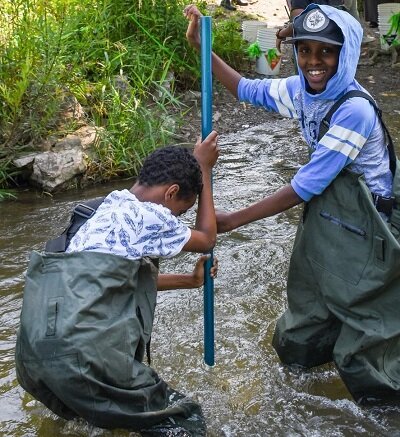EcoSpark Blog
EcoSpark’s Changing Currents Program is the perfect experience for students to go green
Water quality monitoring through Changing Currents goes beyond being an outdoor experience that helps students explore the overall health of watersheds in their community.
Fresh Water in a Changing Climate
Fresh water is the cornerstone of life everywhere. It’s necessary to keep our bodies healthy and thriving, and is an integral part of our well-being and happiness.
Changing Currents Site Spotlight: Glen Steward Ravine
Glen Stewart Ravine is another great example of a green gem hidden within the bustling city limits of Toronto.
Take Action: Remaining Engaged
Now that you have finished your stream study get active in your local schools and communities and try out some of these cool projects.
Action Research in Education: A look into Changing Currents
Action Research in education involves teachers identifying a question focused on their own teaching practice and then planning to take action with their students to help answer that question.
Feet First: Students Plunge in Evaluating their Local Streams
I had just looked up from the bug cupped in the hands of one eager student when I saw something that immediately brought a smile to my face. Another young girl who, unlike most of the other students, was not wearing rubber boots had decided to join her classmates in the water despite having only running shoes.
Milliken Students Take a Stand: The Mission, Protect the Water and Ecology in Markham
This blog was contributed by Milliken Mills students Shamar Brown and Thuvarakan Jeyasanthan. These students were inspired by the Changing Currents program to take action in protecting their local environments.
From Creepy to Cute: How Stream Assessment Changed my View on Insects
A few days ago, I went with EcoSpark to a small stream in Unionville called Bruce Creek, which I hadn’t known was even there, to do stream assessments with people from my school - Milliken Mills High School.
Climate Connection through Changing Currents
Climate change and the recent severe weather events that have come with it are a growing concern around the world. One way scientists see the impacts of climate change is through environmental monitoring.
Happy World Monitoring Day!
Happy World Water Monitoring Day! World Water Monitoring Day takes place each year on September 18. Every year, the World Water Monitoring Challenge, now known as the EarthEcho Water Challenge, seeks to build public awareness and encourage involvement in protecting water resources.
Bug Blog #10: Caddisfly: Flies in Fashion
Welcome back to our tenth and final edition of Bug Blogs, celebrating Science Odyssey by showcasing benthic macroinvertebrates (bugs!) that we often find during our local stream studies program, Changing Currents.
Bug Blog #9: Snails AKA The Stomach Foot
Snails or gastropods are the second most abundant group of species outmatched only by insects. Consisting of snails and slugs, there are over 60,000 different species of gastropods known to date, over 5000 of which are considered to be aquatic.
Bug Blog #8: The Dragonfly: Nature’s Pest Control
In this entry in our Bug Blog series we will be looking at the dragonfly. Dragonflies are easily distinguishable by their long thin bodies, long horizontally resting wings and large compound eyes on either side of its head.
Bug Blog #7: Crayfish: The River Lobster
In this installment of our Bug Blog series we will be exploring the crayfish. If you have ever spent time on the river’s edge you have probably spotted these lobster-looking critters. Compared to other benthos, the crayfish can grow to be quite large, anywhere between 4 to 16 centimeters!
Happy Outdoor Classroom Day!
Today is a day to motivate, celebrate (or even re-invigorate) outdoor education. When teaching and learning outside, there are so many opportunities to seize.
Bug Blog #6: Aquatic beetles: No Punch backs
This next series will cover the aquatic beetle. Beetles are considered to be the most diverse type of insect in the entire animal kingdom with over 350,000 different species discovered to date with over 5000 living in North American waters.
Bug Blog #5: Fun with Flatworms
Have you ever accidentally stepped on a worm but one half managed to get away alive? Even if you haven’t experienced this phenomenon, you have probably heard of it. As long as its major organs are not harmed, a worm that has lost part of its end portion can live. This is also the case for the subject of this installment of the Bug Blog, the flatworm!
Bug Blog #4: Our Bud, The Scud
In this installment of EcoSpark’s Bug Blogs, we will be examining scuds. Scuds are one of the easiest bottom dwelling bugs to identify in aquatic ecosystems due to their resemblance to shrimp.
Bug Blog #3: Kicking Back With The Crane Fly
Have you ever seen a daddy long-legs in your house or outside on a warm autumn day? If you said yes, then you’ve seen a crane fly! Crane flies are the topic of this installment of Bug Blog.
Bug Blog #2: Leeches: The Modern Doctor
Have you ever taken a dip in a lake and come out with a tiny black or grey worm-like organism attached to you? If so, you’ve likely had an encounter with the subject of this edition of the Bug Blog, a leech!




















